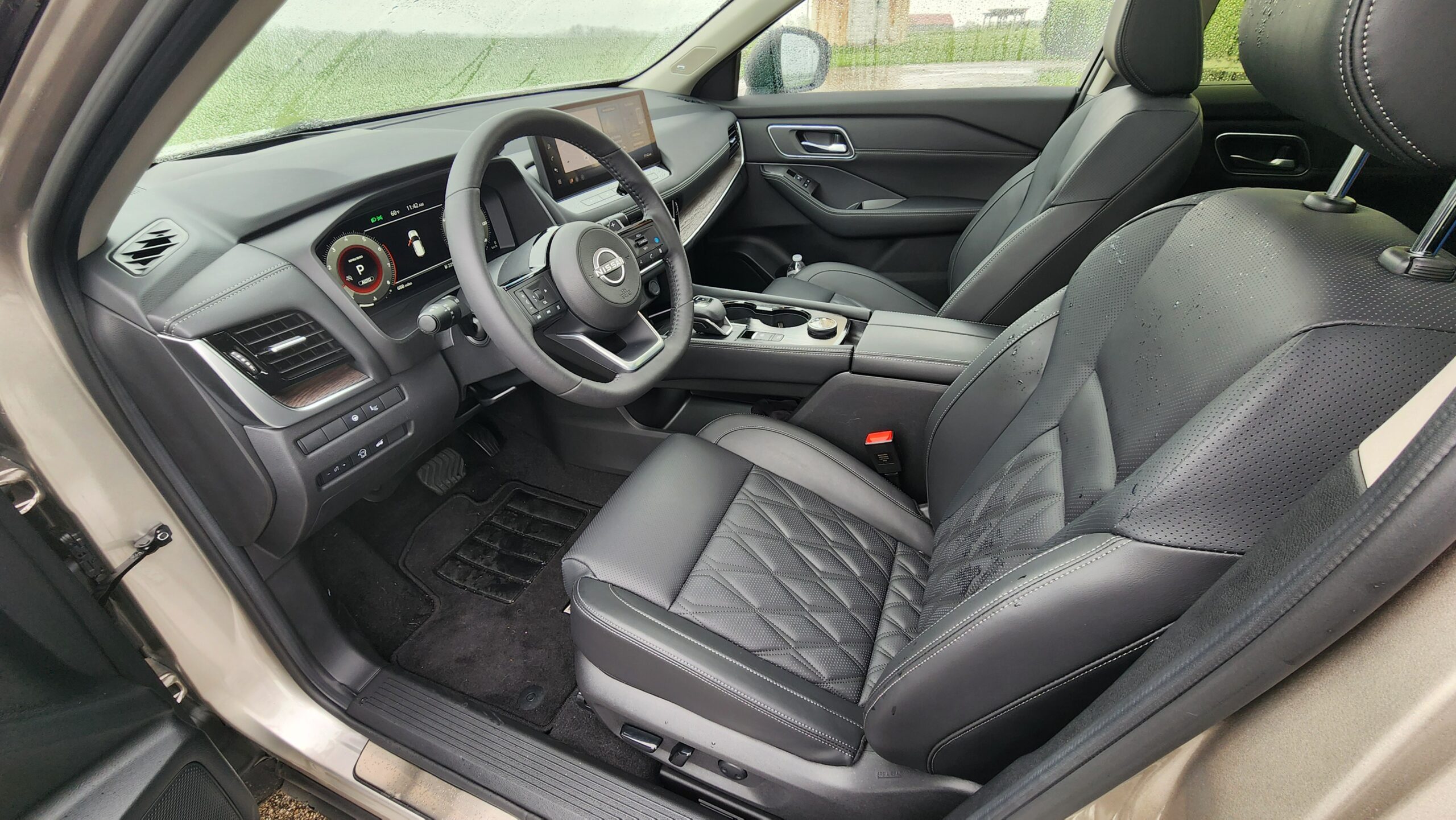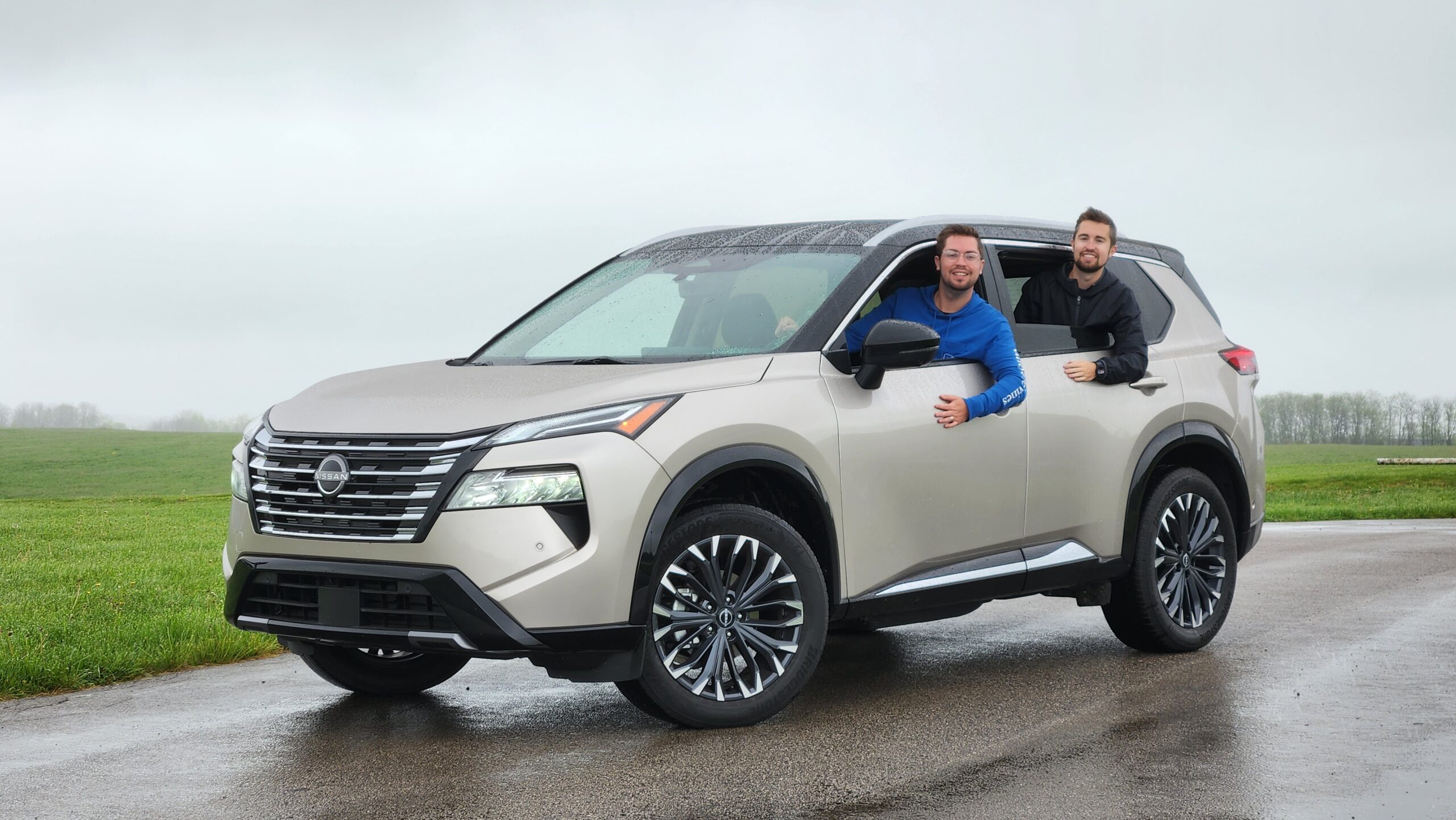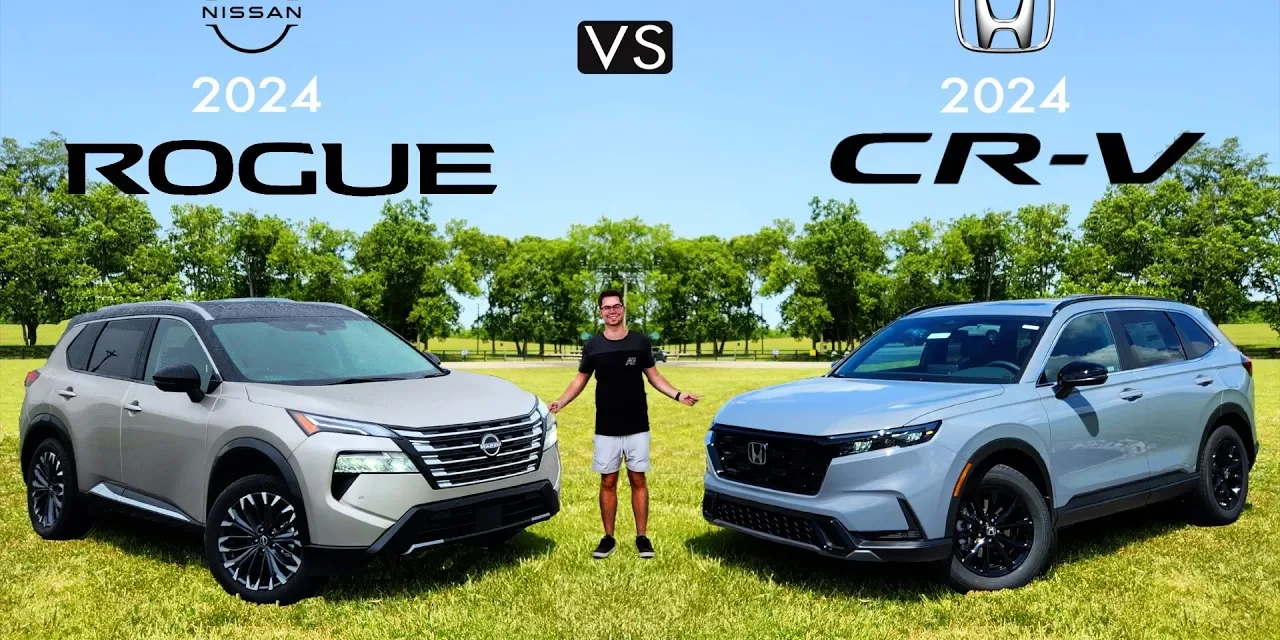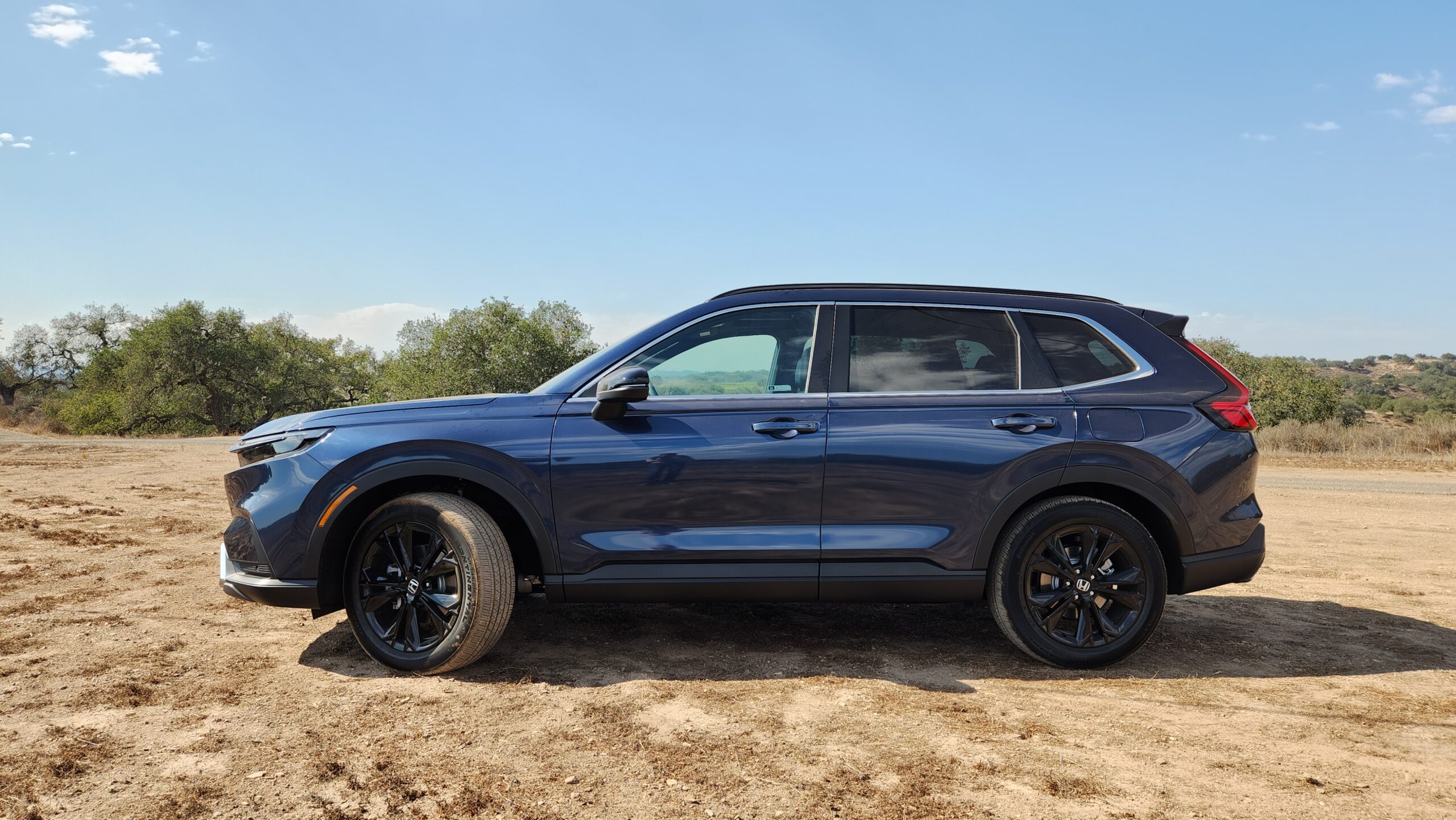Back when we were growing up in the 2000’s, the go-to family vehicle was the mid-size sedan, but that has certainly changed over the years. Now instead of picking Accords and Altima’s, people now tend to choose between CR-V’s and Rogues… which is exactly what we will be comparing today! These two popular products are best-sellers for each respective brands, and they have both recently undergone major changes with redesigns and refreshes. So, who wins in a 2024 Honda CR-V vs. 2024 Nissan Rogue battle? Well, let’s dive in to find out!
Pricing and Equipment
So, first off, to get things established, let’s quickly talk pricing for these two.
Starting with the all-new CR-V, we have the fully loaded model, which is known as Sport Touring. This top model comes standard with every single option available, making its total price $41,550, after destination.
CR-V (Sport Touring AWD): $40,200 | Options: +$0 | Destination: $1,350 | Total: $41,550
Moving to the Nissan Rogue, we have the Platinum spec. While that is the top trim, with the exact same MSRP, you can still add a few options to make it fully loaded, and once you do that, the total price rises to $43,330.
Rogue (Platinum AWD): $40,200 | Options: +$1,740 | Destination: $1,390 | Total: $43,330
By the way, if you want to get the best price from local dealerships and access to invoice pricing info for these two models or any vehicle, we have a tool on our website to do just that. Click here for more information!
Exterior Design
Now, kicking things off with the exterior designs, both brands have carefully considered how to make the designs nice but also inoffensive at the same time. The Honda leans on the sportier side of things, with a blacked-out grille, while the Platinum Rogue goes for a flashier look with its large silver grille.
As far as lighting is concerned, both go with full-LED arrangements, including the DRL and turn signals. Neither of them has fog lamps.
Continuing around to the sides, they are sized neck-in-neck, and both have 19-inch alloy wheels to spice up the looks. One extra thing that only the Rogue offers is a two-tone paint scheme for those who like some extra contrast.
Length: 184.8-inches (CR-V) | 183.0-inches (Rogue)
And then heading out back, we continue to see classy designs with each brands signature looks. Features-wise, they have spoilers, exposed wipers, and partially LED taillights clusters, with only the CR-V including exposed exhaust tips.
For those of you interested in towing small trailers, the Rogue can handle up to 1,500 lbs. vs. 1,000 in the CR-V.
Additional Features
Next, checking out some of the individual odd and end features, both of their mirrors have heating and blind spot monitoring, but no power folding abilities.
In addition to BSM, these crossovers also come standard with all the available major active safety features, [p] and their warranties are the same with the exception of Honda having complimentary maintenance for the first 2 years of ownership.
But things are going to get even more interesting on the inside, so let’s get into that!


Interior Design
Approaching both models, you will find smart entry systems and built-in remote start, as expected for the loaded versions. There is a small difference between them though, which is that the Rogue doesn’t have a sensor behind the door handle, so you must press the button to unlock.
Now once you open up the doors, you’ll find nice looking interiors, surprisingly nice if you haven’t been in a modern compact crossover recently. This segment is so competitive that brands pull out all the stops to stand out, such as the Rogue using semi-analine leather for the seats. That’s a top-tier grade of leather and is suppler than the CR-V’s normal leather.
Other seat considerations include the same number of power adjustments, memory seats and heating, and neither offer ventilated seats at this time.
Now once we climb inside the cabins, we can check out the major point category of material quality. Here, both feel solid, but the Rogue pulls ahead. It has a richer assortment of materials, such as leatherette across the dash and lining the center tunnel, as well as a faux wood in place of the piano black trim you get on the CR-V.
Once you fire the two crossovers up, you’ll see a half digital and half analog gauge cluster on the CR-V and a 12.3-inch fully digital cluster on the Rogue. The Nissan also has a head-up display which is not offered on the Honda.
After pulling back past the CR-V’s rain-sensing wipers, we have heated and leather-wrapped steering wheels.
Storage and Technology
But moving on to another major point, let’s talk interior storage. Hondas are known for making the most of the available space and indeed it does have a class-leading 9L’s of center console space. However, what the Rogue lacks in console storage, it makes up for with center pass through, so we will call this area even.
Note: both have wireless phone chargers
Looking at the shifters next, the Rogue’s floating console is made possible by the electronic shifter it is using, compared to the traditional kind in the Honda. Regardless of your personal preference here, when you go into reverse, it is only the Rogue that will display a 360-degree camera system for parking.
Both crossovers have physical controls for climate adjustment, and Rogue has an extra trick up its sleeve that we will talk about later. We also have traditional volume knobs to control the Bose sound systems. As you would expect, the sound largely the same.
Rogue: 10-speaker Bose CenterPoint audio
CR-V: 12-speaker Bose CenterPoint audio
Alright, so now let’s talk about the displays because we have big differences here. First off, the sizes: 9-inches in the Honda and 12.3 in the Nissan. When it comes to screen-sizes, a 3-inch difference is substantial.
The software experience has a more advanced look on the Rogue as well, but as far as actual scorable differences, there really are none as both of them have wireless AA and ACP and built-in navigation.
One thing that is scorable though is the lack of HomeLink remotes on the CR-V’s auto-dimming mirror, and its lack of a panoramic moonroof option, which the Rogue offers on almost all trims.


Rear Seats and Cargo
Now heading to the rear areas, things are heating up even more. Specs-wise, the CR-V’s massive 41-inches of legroom is basically impossible to beat in this segment, but the headroom is in the Rogues favor, though not by enough to earn a point.
CR-V: 41.0 inches of legroom | 38.2-inches of headroom
Rogue: 38.5 inches for legroom | 39.2-inches headroom
The other advantage when it comes to rear seat comfort is that the CR-V’s seats recline far with 8 levels you can choose from for max comfort.
As far as the features back here, both models have rear vents and 2 USB-C ports for charging devices, but you’ll notice two extra items in the Rogue: 3-zone climate controls, and heated back seats.
Moving out back, the two crossovers have power tailgates with hands-free access, but as your momma taught you, it’s what’s on the inside that is most important.
Back about 5 years ago, the CR-V was the undisputed cargo capacity champ but at the max configuration this Rogue has largely caught up. There is only a 3% difference in space between them, which is not enough for the CR-V to score a point, but critically, with the seats in upright, the CR-V has 8% more space, which is enough to matter and score a point.
CR-V: Behind 2nd row: 39.3 cubic feet | Max: 76.5 cu.ft
Rogue: Behind 2nd row: 36.5 cubic feet | Max: 74.1 cu.ft
Alright, we’re done with the interiors now, so it’s time to take this fight to the streets.


Powertrains
Doing different things to get similar results would be a great theme for this powertrain performance discussion. As emission standards have increased, both brands came up with ways to meet them: CR-V is exclusively powered by the 2.0L two-motor hybrid system on the Sport Touring, making 204 hp. The Rogue eschews away from hybridization is favor of engine downsizing, using a 1.5L variable compression turbo 3-cylinder, making 201 hp. While the horsepower figures are almost identical, the CR-V does have nearly a 10% advantage in torque.
CR-V: 2.0L I-4 + Elec: 204 hp | 247 lb.ft
Rogue: 1.5L VC-Turbo I-3: 201 hp | 225 lb.ft
As far as the transmissions, the CR-V utilizes an eCVT-like transmission, and the Nissan uses a conventional CVT. Both have shift simulations, AWD systems and several drive modes.
Test Drive and Fuel Economy
Now after you have your need-for-speed satisfied, let’s get everything quieted down at highway speed and take our sound level readings. That’s something we always like to do here at Car Confections to find out what the quietest options in the class are. In this test, the Rogue scored a lower reading, even with rain on the roads.
CR-V: 57.0 dB @ 55 MPH
Rogue: 54.7 dB @ 55 MPH
Now let’s talk about one of the underrated elements: driving dynamics. Both are pretty good, but the CR-V is better with a nice body control when cornering and linear steering.
Ride quality is excellent on both models, and all but the largest bumps are mostly dampened out as to not disturb the family.
Now let’s talk fuel economy. While Rogue claims the best-in-class gas only fuel economy, it still falls 6 MPG behind the CR-V Hybrid. That adds up over time, and as mentioned earlier, the Rogue doesn’t have a hybrid version here in the U.S.
CR-V: 40/34/37 MPG
Rogue: 28/34/31 MPG
Resale and Reliability
In our reviews and comparisons, we are also adding in reliability and resale information to give you a better picture of the overall value beyond just the original MSRP.
Beginning with reliability, we developed the Combined Reliability Index, which takes into account several studies from trustworthy sources, and combines them in a way that gives a more realistic picture. Honda ranks 14 slots ABOVE the industry average for all brands in reliability. But, Nissan is close to the industry average, coming in 2 slots BELOW average.
We also put Mason’s economics degree to work to develop a detailed Predicted Resale Value tool. Honda is THE top brand for the highest predicted resale value, with 64.79% of value retained after 5 years. Nissan rates a good deal lower, at 50.56% resale value, which would result in a CR-V being worth about $4,000 more after 5 years.
Resale is obviously important because it determines how much money you get back, but we can’t forget about the price difference at the original purchase. The Rogue costs $1,780 more than the CR-V.
I want to emphasize that if money, reliability or resale value matter less to you personally, feel free to disregard these points. And if you’d like to check out all our data about reliability and resale values, as well as learn about our methodology, make sure to head to www.carconfections.com/resale and www.carconfections.com/reliability. Buying a car is a big decision, and this is a great place to compare all the makes you might be cross-shopping.
2024 Honda CR-V vs. 2024 Nissan Rogue winner!
So, there you have it; we end up with another tight comparison race as expected. But let’s summarize to figure out who should be “your” personal winner.
Rogue:
- Extra luxury features
- Don’t want a hybrid
- Better tech
CR-V:
- Hybrid powertrain experience (slightly more powerful and better fuel economy)
- Better resale and reliability rankings
- More space
Now we want to know your opinions, so make sure to head to the comment section and let us know which one you would pick!
Thanks for joining us for another Car Confections Comparison! We’ll catch you next time as we sample the latest automotive delicacies!














Recent Comments